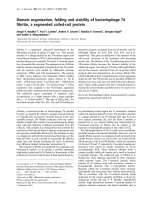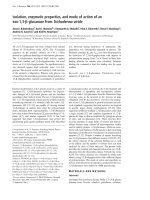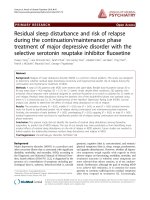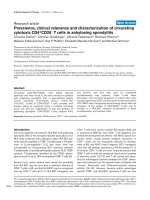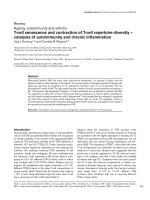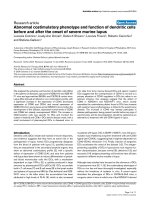Báo cáo y học: "Bench-to-bedside review: Significance and interpretation of elevated troponin in septic patients" ppt
Bạn đang xem bản rút gọn của tài liệu. Xem và tải ngay bản đầy đủ của tài liệu tại đây (58.56 KB, 6 trang )
Page 1 of 6
(page number not for citation purposes)
Available online />Abstract
Because no bedside method is currently available to evaluate
myocardial contractility independent of loading conditions, a
biological marker that could detect myocardial dysfunction in the
early stage of severe sepsis would be a helpful tool in the manage-
ment of septic patients. Clinical and experimental studies have
reported that plasma cardiac troponin levels are increased in
sepsis and could indicate myocardial dysfunction and poor
outcome. The high prevalence of elevated levels of cardiac
troponins in sepsis raises the question of what mechanism results
in their release into the circulation. Apart from focal ischemia,
several factors may contribute to the microinjury and minimal
myocardial cell damage in the setting of septic shock. A possible
direct cardiac myocytotoxic effect of endotoxins, cytokines or
reactive oxygen radicals induced by the infectious process and
produced by activated neutrophils, macrophages and endothelial
cells has been postulated. The presence of microvascular failure
and regional wall motion abnormalities, which are frequently
observed in positive-troponin patients, also suggest ventricular wall
strain and cardiac cell necrosis. Altogether, the available studies
support the contention that cardiac troponin release is a valuable
marker of myocardial injury in patients with septic shock.
Introduction
In 2000, the Joint European Society of Cardiology/American
College of Cardiology Committee proposed a new definition
of myocardial infarction based predominantly on the detection
of the cardiospecific biomarkers troponin T and troponin I in
the appropriate clinical setting [1]. Given that cardiac
troponin is highly sensitive for detecting even minimal
myocardial-cell necrosis, these markers may become
‘positive’ even in the absence of thrombotic acute coronary
syndromes [2]. This may occasionally be related to a spurious
troponin elevation but may also be due to several non-
thrombotic cardiac and systemic diseases [2-4]. Sepsis and
other systemic inflammatory processes may lead to
myocardial depression and cellular injury, greatly increased
oxygen consumption, reduced microvascular circulation, and
decreased oxygen delivery to the heart, ultimately resulting in
the release of troponin into the systemic circulation [5]. The
aim of this review is to go from bench to bedside to
determine what evidence and interests are able to incite
intensivists to evaluate the cardiac troponin plasma marker in
the context of sepsis.
Limitations in cardiac assessment at the
bedside
Abnormalities of cardiac function are frequent in patients with
sepsis. Approximately 50% of patients with severe sepsis
and septic shock may develop impairment of ventricular
performance. Whereas evaluation of myocardial performance
during septic shock is of critical importance to select the best
therapeutic options, several factors complicate the diagnosis
of sepsis-induced myocardial dysfunction in humans. Making
accurate measurements of cardiac function is difficult and
this is confounded by the inherent difficulty of excluding
patients with true coronary insufficiency with sepsis. The
available evaluation methods have their strengths and
limitations, leading to an absence of consensus regarding the
gold standard technique to assess cardiac function. In
addition, most of the contractility indexes are affected by
peripheral vasodilatation and changes in loading conditions
observed in septic shock. In addition, catecholamine stress
observed in sepsis stimulates the myocardium and may,
therefore, mask myocardial depression. Since alteration of
myocardial performance in sepsis may be related to structural
abnormalities of the heart, biochemical markers could thus be
useful in the diagnosis of sepsis-induced myocardial
dysfunction. Recently, plasma cardiac troponin has been
proposed as a biomarker that accurately detects myocardial
dysfunction and provides prognosis information in septic
patients.
Review
Bench-to-bedside review: Significance and interpretation of
elevated troponin in septic patients
Raphael Favory
1,2
and Remi Neviere
1
1
Physiology Department, School of Medicine, EA2689 University of Lille, France
2
Medical Intensive Care Unit, Universitary Hospital of Lille, France
Corresponding author: Remi Neviere,
Published: 4 August 2006 Critical Care 2006, 10:224 (doi:10.1186/cc4991)
This article is online at />© 2006 BioMed Central Ltd
IL = interleukin; TNF = tumor necrosis factor.
Page 2 of 6
(page number not for citation purposes)
Critical Care Vol 10 No 4 Favory and Neviere
What are troponins?
Cardiac troponins are regulatory proteins that control the
calcium-mediated interaction of actin and myosin. The
troponin complex consists of three subunits: troponin T,
which binds to tropomyosin and facilitates contraction;
troponin I, which binds to actin and inhibits actin-myosin
interactions; and troponin C, which binds to calcium ions
[2,6]. The amino acid sequences of the skeletal and cardiac
isoforms of cardiac troponin T and troponin I are sufficiently
dissimilar and, therefore, differentially detectable by
monoclonal antibody based assays. Troponin C is not used
clinically because both the cardiac and skeletal muscle share
troponin C isoforms. Cardiac troponin I is 13 times more
abundant in the heart than creatine kinase MB isoenzyme, so
the signal-to-noise ratio associated with troponin I is much
more favorable for the detection of minor amounts of cardiac
damage. Cardiac troponin T is as abundant as troponin I in
the heart [7].
Origin of cardiac troponin release
Normally, cardiac troponins T and I are not detectable in the
blood of healthy persons. Release of these troponins can
occur when myocytes are damaged by a variety of conditions,
such as trauma, exposure to toxins, inflammation, and necrosis
due to occlusion of a portion of the coronary vasculature [2-
4,8]. The majority of cardiac troponin T and cardiac troponin I
is bound to myofilaments, and the remainder is free in the
cytosol. When myocyte damage occurs, the cytosolic pool is
released first, followed by a more protracted release from
stores bound to deteriorating myofilaments [9].
Abnormal values have been described in various conditions
not related to acute coronary disease, like myocarditis,
pulmonary embolism, acute heart failure, septic shock, and as
a result of cardiotoxic drugs as well as after therapeutic
procedures, such as coronary angioplasty, electrophysio-
logical ablation, or electrical cardioversion [3]. The
mechanisms of release and clearance of cardiac troponins T
and I are complex and incompletely understood in these
pathological conditions. Although both are structural proteins,
it has been suggested that cytosolic pools of these proteins
are released into the circulation after cell injury. The cytosolic
pool for cardiac troponin T was estimated at 6% to 8% of
total cardiac troponin and that for soluble cardiac troponin I at
2.8% of total cardiac troponin. Release of cardiac troponin T
may be related to transient leakage from the cytosolic
component due to loss of sarcolemmal integrity during
reversible ischaemia, or from its continuous release when
ischaemic injury is irreversible [3,10].
How is heart tissue damaged in sepsis?
The high prevalence of elevated serum levels of cardiac
troponins in septic shock raises the question of what
mechanism results in troponin release in septic shock.
Proposed mechanisms include focal ischemia, and direct
cardiac myocytotoxic effects of endotoxins, cytokines or
reactive oxygen radicals [4,11]. In addition, activation of many
intracellular pathways may cause degradation of free troponin
to lower molecular weight fragments, which are released into
the systemic circulation because of increased membrane
permeability [9,11]. The current understanding of myocardial
dysfunction in sepsis is that there is no evidence of global
coronary hypoperfusion. Tools for assessing tissue and heart
dysfunction have, however, evolved and enable us to
reconsider the above assumption as a universal concept. In
this respect, microvascular dysfunction is now considered an
intrinsic aspect of sepsis sequelae. Indeed, evidence
suggests that sepsis may induce perturbations in regional
coronary blood flow and microvascular failure leading to
myocardial ischemia [12].
Myocardial depressant substances
The phenomenon of myocardial depression can be mediated
by circulating depressant substances, which until now have
been incompletely characterized. Among those possible
candidates, tumor necrosis factor (TNF), IL-1β and IL-6 play a
central role in septic myocardial dysfunction [13]. TNF-α,
alone or in association with IL-1β, has been implicated in the
pathophysiology of septic myocardial dysfunction [13].
Proposed mechanisms of TNF-α-induced myocardial
depression include the activation of the neutral sphingo-
myelinase, and suppression of the calcium transient and nitric
oxide pathways. TNF-α can also modulate tissue destruction
and biosynthesis/activation of intracellular proteases [13]. For
example, TNF-α may induce activation of calpains and
caspases that could participate in the degradation of crucial
cardiac contractile proteins, including troponins. Upon
activation by calcium, active calpain is released by calpastatin
and cleaves cardiac troponin I at the carboxyl terminus to
produce the cardiac troponin I degradation fragment [13].
Caspases, the executioners of apoptotic cell death, also
induce sarcomere disarray and are involved in the cleavage of
α-actin, α-actinin and troponin T [14]. Alternatively, TNF-α
may have an important role in cardiac injury through a variety
of mechanisms, including second messenger pathways,
arachidonate metabolism, protein kinases, oxygen free
radicals, nitric oxide, transcription of a variety of cytotoxic
genes, regulation of nuclear regulatory factors, ADP-ribosy-
lation and, potentially, DNA fragmentation [13]. In this setting,
histology of transgenic mice specifically overexpressing
TNF-α in the heart shows hypertrophied interstitial connective
tissue cells associated with focal myocyte degeneration and
injury [13,15]. Transmission electron microscopy further
demonstrated myofibril disarray and breakdown in TNF-α
transgenic mouse heart [13,16]. Altogether, these derange-
ments in heart tissue architecture could participate in the
breakdown of sarcomeric proteins and their release in the
systemic circulation.
Leukocyte and reactive oxygen species
Reactive oxygen species may play a role in the induction of
several types of organ failure, including that of the heart,
Page 3 of 6
(page number not for citation purposes)
following the development of sepsis. Leukocyte derived
superoxide and its daughter molecules are thought to be a
major cause of heart injury in sepsis [17]. In addition,
activated NADPH oxidase complexes and mitochondria are
also potential sources of free radicals in the septic heart,
which may have multiple potential sites of action [18]. Under
pathophysiological conditions, dramatically elevated levels of
reactive oxygen species may cause significant damage to
cellular proteins and membranes as well as to nucleic acids,
leading to single strand breaks and chromosomal alterations,
which are all likely to induce cardiac cell death. Consistent
with this hypothesis are the fascinating findings of Ammann
and colleagues [19], who reported that plasma troponin
levels became positive during leukocyte recovery in aplastic
patients with septic shock and indicated poor outcome.
Myocardial perfusion abnormalities
Typically, global myocardial ischaemia has not been
considered a critical factor of septic heart dysfunction
[20,21]. Detailed analysis of existing literature may, however,
lead to the contrasting conclusion that myocardial ischemia
or microcirculation abnormalities are present in septic shock.
Experimental studies suggest that generalized microvascular
dysfunction is a prominent feature of septic shock and is
probably an important factor in the heart, as elsewhere [22].
This could lead to relative ischaemia, microvascular shunting,
or flow heterogeneity secondary to mechanisms such as
endothelial dysfunction, leucocyte plugging of capillaries,
interstitial edema and free radical production. Growing
evidence suggests that reversible mismatched perfusion
metabolism areas inherent to local redistributive micro-
circulatory adjustment are present in experimental sepsis,
suggesting an ischemic component is partially responsible for
heart dysfunction [23-25]. Specifically, decreased myocardial
microcirculatory flow and random oxygen consumption have
been experimentally demonstrated by means of positron
emission tomography imaging in endotoxic shock [24].
Heart apoptosis
Despite extremely low levels of myocyte nuclear apoptosis,
caspase activation has been implicated in sarcomere disarray
and contractile dysfunction in various models of myocardium
injury [26]. Caspase activation participates in the regulation
of cardiac contractility and its inhibition might reverse
depressed contractility. Many putative caspase cleavage
sites in cardiac contractile and structural proteins may be
identified through data bank research with caspase cleavage
motifs. The existence of such cleavage sites explains the
findings that exposure of myofibrillar proteins to active
caspase 3 results in α-actin, α-actinin and troponin T and
myosin light chain cleavage [14]. In experimental sepsis, our
studies suggest that activation of caspase 3 plays an
important role in endotoxin-induced cardiomyocyte dys-
function, which is related to changes in calcium myofilament
response, troponin T cleavage and sarcomere disorganization
[26].
What mechanisms of troponin increase are
possible in clinical sepsis?
Does cardiac ischemia occur in septic patients?
Two elegant studies have shown that coronary blood flow is
increased and not decreased in septic shock, even if
energetic substrate extraction is altered [20,21]. Preservation
of coronary flow, net myocardial lactate extraction, and
increased availability of oxygen to the myocardium argue
against global ischemia as a cause of septic myocardial
depression. In addition, nuclear magnetic resonance studies
have shown normal myocardial high energy phosphate levels.
In these studies, however, myocardial ischemia is difficult to
rule out. First, the results of these studies suggest evidence of
myocardial hypoxia (zero or negative lactate uptake) in 15% of
studied patients [21]. Second, autopsies of septic patients
provide circumstantial evidence that histological changes can
be related to heart ischemia. For example, in a retrospective
review of autopsy findings in 71 patients, Fernandes and
colleagues [27] noted abnormalities in the myocardium,
including interstitial myocarditis (27%), interstitial edema
(28%), and muscle-fiber necrosis (7%). These data also
support an opinion that structural injury to the contractile
apparatus or microcirculation of the heart may contribute, at
least partly, to myocardial dysfunction in sepsis [28].
Does demand ischemia exist in septic shock?
Cardiac output is typically increased in sepsis, meaning
increased work for the cardiac pump, that is, increased
oxygen demand. Tachycardia can further decrease oxygen
supply because diastolic time, during which myocardial
perfusion occurs, is reduced. Coronary flow reserve can thus
be reduced, with a potential mismatch between oxygen
demand and supply causing demand ischemia. In addition,
aggressive inotropic treatment to boost systemic oxygen
delivery may increase the incidence of cardiovascular
complications and adversely affect outcome in fluid
resuscitated septic patients. It is quite possible that elaborate
attempts at prolonged resuscitation could either cause or
disclose ischemic myocardial damage. Increased cardiac
filling pressures and increased wall stress may contribute to
myocyte damage and microinjury in septic shock [2].
Could increase of cardiomyocyte permeability explain
troponin leakage?
Circulating mediators such as TNF-α have been implicated in
increased permeability of sarcolemmic cardiomyocyte mem-
brane, a phenomenon that could explain troponin release
without irreversible injury [9]. TNF-α may increase the
permeability of endothelial monolayers to macromolecules
and lower molecular weight solutes and it is likely that similar
alterations in permeability also occur at the level of myocyte
cell membranes, thus leading to leakage of cardiac troponin I
[12]. Indeed, release of myocardial enzymes from mammalian
myocardiocytes into cell supernatant has been demonstrated
during limited periods of hypoxia [29]. In human volunteers,
no correlation between plasma levels of TNF-α and troponin
Available online />could be found in endotoxin-treated volunteers, suggesting
that TNF-α alone may not be sufficient to induce increased
permeability [30]. In sharp contrast, levels of TNF-α, its
soluble receptor and IL-6 are significantly higher in troponin-
positive septic shock patients than those of troponin-negative
patients, suggesting that cytokines in combination may
provoke an increase in membrane permeability and troponin
release [19].
Are increased troponin levels related to
ischemic cardiac tissue damage in clinical
sepsis?
Many studies in sepsis have shown that continuous ECG
monitoring and transthoracic echocardiography examination
at diagnosis do not disclose developing ischemia and
exclude myocardial infarction [19,31-37]. In troponin-positive
septic shock patients, the presence of myocardial ischemia
has been excluded based upon results of stress echocardio-
graphy [19,31,38]. It should be pointed out, however, that
stress echocardiography cannot definitely exclude micro-
embolization from non-flow limiting unstable plaques as well
as local wall motion abnormalities as a cause of elevated
troponins. In this specific context, even very small episodes of
myocardial necrosis (< 1 g) may be associated with
significant troponin increases [2].
The presence of some degree of focal cardiac necrosis in
septic patients has been emphasized by recent anatomo-
pathological findings. Indeed, troponin-positive septic shock
patients tend to show more pronounced histological
abnormalities than troponin-negative septic shock patients
[31,37]. Specifically, contraction band necrosis, an early
marker of irreversible myocyte injury, and sarcoplasmic fibril
rupture are more frequent in troponin-positive septic shock
patients [37]. Contraction band necrosis is believed to result
from calcium overload and its presence is typically associated
with focal ischemia reperfusion injury and the use of high
catecholamine concentrations.
Does increased troponin level indicate
cardiac dysfunction and poor outcome in
clinical sepsis?
A correlation between troponin level and requirements for
inotropic support has been mentioned by some authors
[36,39], whereas others have shown opposite results
[37,38]. In patients with increased troponin levels, evaluation
of myocardial performance during septic shock has been
performed by the means of left ventricular stroke work index
calculation [5,39] and evaluation of systolic function by echo-
cardiography [19,33,35,37,38,40]. Consistently, estimates of
left ventricular ejection fraction and fractional area contraction
correlate negatively with increased levels of cardiac troponin I
in both adults and children with septic shock [35,38,41,42].
Also, serial determinations of cardiac troponin I show a
negative correlation between serum concentrations of cardiac
troponin I and myocardial function (echocardiography
fractional area contraction less than 50%) [41]. However, a
correlation between left ventricular dysfunction and increased
levels of cardiac troponin I is not a universal finding in septic
shock patients [43]. The reason for these contrasting results
has not been reconciled. However, it should be pointed out
that several factors may complicate the diagnosis of sepsis-
induced myocardial dysfunction in humans and
echocardiography derived parameters may not reflect actual
myocardial contractility and dysfunction [41,42].
In addition to global systolic and diastolic performance
evaluation, tissue velocity imaging for myocardial strain and
strain rate imaging is an important development in the field of
cardiac ultrasound that provides quantitative information for
analysis of myocardial motion. Increased wall strain and
regional wall motion abnormalities in septic shock could be
part of the septic myocardial dysfunction pattern and account
for cardiac myolysis. Although regional wall motion
abnormalities have been observed in some positive-troponin
cases [36], there is no information with respect to
perturbations in tissue Doppler derived myocardial strain and
strain rate in septic shock patients.
Eventually, a prognosis of sepsis depends on the severity of
organ dysfunctions, in particular, cardiovascular failure.
Whether an elevated troponin level represents a critical and
independent parameter of outcome has been debated in
many clinical studies [5,8,20,34,36,40-43]. Studies in
unselected critically ill patients yield the consistent
information that mortality among troponin-positive patients is
higher than troponin-negative patients, irrespective of the
cause of troponin increase. In studies restricted to patients
with sepsis, elevated troponin levels have been shown to be
related to the severity of the disease. Overall, these results
are very similar in showing that troponin elevation indicates a
worse myocardial function and unfavourable outome
[5,19,31,34,36,37,39].
It should be pointed out, however, that the relative expected
and documented ranges of troponin that can be seen in
sepsis are rather difficult to depict because there is huge
variability in the sensitivity of assays (Table 1). The
appropriate cut-off value for each assay is unique and cannot
be compared with any other. These differences are due in
part to the heterogeneity of the antibodies and matrix
components of the assays. They are also due to the fact that
there are various fragments of troponin that circulate, and the
antibodies used in the various assays detect these fragments
differently [3,7,10].
Conclusion
Although the mechanisms of troponin release into plasma
during sepsis are not clearly established, cardiac troponin I is
an indicator of myocardial injury in septic patients and is
potentially associated with myocardial depression and poor
outcome. There is evidence from several small studies that
Critical Care Vol 10 No 4 Favory and Neviere
Page 4 of 6
(page number not for citation purposes)
elevated cardiac troponin levels in patients with sepsis
indicate myocardial dysfunction and a poor prognosis.
However, further studies are needed to elucidate the
potential of troponins to characterize the severity and course
of the septic cardiomyopathy. Cardiac troponin I, in
association with markers of myocardial depression such as
natriuretic peptides, seems to be an early factor of prognosis
and cardiac dysfunction in patients with sepsis.
Competing interests
The authors declare that they have no competing interests.
References
1. Joint European Society of Cardiology/American College of Cardi-
ology Committee: Myocardial infarction redefined - a consen-
sus document of The Joint European Society of Cardiology/
American College of Cardiology Committee for the redefini-
tion of myocardial infarction. Eur Heart J 2000, 21:1502-1513.
2. Jeremias A, Gibson CM: Narrative review: alternative causes
for elevated cardiac troponin levels when acute coronary syn-
dromes are excluded. Ann Intern Med 2005, 142:786-791.
3. Hamm CW, Giannitsis E, Katus HA: Cardiac troponin elevations
in patients without acute coronary syndrome. Circulation
2002, 106:2871-2872.
4. Roongsritong C, Warraich I, Bradley C: Common causes of tro-
ponin elevations in the absence of acute myocardial infarction:
incidence and clinical significance. Chest 2004, 125:1877-1884.
5. Spies C, Haude V, Fitzner R, Schroder K, Overbeck M, Runkel N,
Schaffartzik W: Serum cardiac troponin T as a prognostic
marker in early sepsis. Chest 1998, 113:1055-1063.
6. Akhtar S, Silverman DG: Assessment and management of
patients with ischemic heart disease. Crit Care Med 2004, 32:
S126-S136.
7. Wu AH, Jialal I: How specific is cardiac troponin? Am J Clin
Pathol 2000, 114:509-511.
8. Quenot JP, Le Teuff G, Quantin C, Doise JM, Abrahamowicz M,
Masson D, Blettery B: Myocardial injury in critically ill patients:
relation to increased cardiac troponin I and hospital mortality.
Chest 2005, 128:2758-2764.
9. Wu AH: Increased troponin in patients with sepsis and septic
shock: myocardial necrosis or reversible myocardial depres-
sion? Intensive Care Med 2001, 27:959-961.
10. Giannitsis E, Katus HA: Comparison of cardiac troponin T and
troponin I assays - implications of analytical and biochemical
differences on clinical performance. Clin Lab 2004, 50:521-
528.
11. van Bockel EA, Tulleken JE, Ligtenberg JJ, Zijlstra JG: Troponin in
septic and critically ill patients. Chest 2005, 127:687-688.
12. Goddard CM, Poon BY, Klut ME, Wiggs BR, vanEeden SF, Hogg
JC, Walley KR: Leukocyte activation does not mediate myocar-
dial leukocyte retention during endotoxemia in rabbits. Am J
Physiol 1998, 275:H1548-1557.
13. Prabhu SD: Cytokine-induced modulation of cardiac function.
Circ Res 2004, 95:1140-1153.
14. Communal C, Sumandea M, de Tombe P, Narula J, Solaro RJ,
Hajjar RJ: Functional consequences of caspase activation in
cardiac myocytes. Proc Natl Acad Sci USA 2002, 99:6252-6256.
15. Janczewski AM, Kadokami T, Lemster B, Frye CS, McTiernan CF,
Feldman AM: Morphological and functional changes in cardiac
myocytes isolated from mice overexpressing TNF-alpha. Am J
Physiol Heart Circ Physiol 2003, 284:H960-H969.
16. Engel D, Peshock R, Armstong RC, Sivasubramanian N, Mann
DL: Cardiac myocyte apoptosis provokes adverse cardiac
remodeling in transgenic mice with targeted TNF overexpres-
sion. Am J Physiol Heart Circ Physiol 2004, 287:H1303-H1311.
17. Granton JT, Goddard CM, Allard MF, van Eeden S, Walley KR:
Leukocytes and decreased left-ventricular contractility during
endotoxemia in rabbits. Am J Respir Crit Care Med 1997, 155:
1977-1983.
18. Supinski GS, Callahan LA: Polyethylene glycol-superoxide dis-
mutase prevents endotoxin induced cardiac dysfunction. Am J
Respir Crit Care Med 2006, 173:1240-1247.
19. Ammann P, Maggiorini M, Bertel O, Haenseler E, Joller-Jemelka
HI, Oechslin E, Minder EI, Rickli H, Fehr T: Troponin as a risk
factor for mortality in critically ill patients without acute coro-
nary syndromes. J Am Coll Cardiol 2003, 41:2004-2009.
20. Cunnion RE, Schaer GL, Parker MM, Natanson C, Parrillo JE: The
coronary circulation in human septic shock. Circulation 1986,
73:637-644.
21. Dhainaut JF, Huyghebaert MF, Monsallier JF, Lefevre G, Dall’Ava-
Santucci J, Brunet F, Villemant D, Carli A, Raichvarg D: Coronary
hemodynamics and myocardial metabolism of lactate, free
fatty acids, glucose, and ketones in patients with septic
shock. Circulation 1987, 75:533-541.
22. Lush CW, Kvietys PR: Microvascular dysfunction in sepsis.
Microcirculation 2000, 7:83-101.
23. Chagnon F, Metz CN, Bucala R, Lesur O: Endotoxin-induced
myocardial dysfunction: effects of macrophage migration
inhibitory factor neutralization. Circ Res 2005, 96:1095-1102.
24. Chagnon F, Bentourkia M, Lecomte R, Lessard M, Lesur O:
Endotoxin-induced heart dysfunction in rats: assessment of
myocardial perfusion and permeability and the role of fluid
resuscitation. Crit Care Med 2006, 34:127-133.
25. Levy RJ, Piel DA, Acton PD, Zhou R, Ferrari VA, Karp JS,
Deutschman CS: Evidence of myocardial hibernation in the
septic heart. Crit Care Med 2005, 33:2752-2756.
26. Lancel S, Joulin O, Favory R, Goossens JF, Kluza J, Chopin C,
Formstecher P, Marchetti P, Neviere R: Ventricular myocyte cas-
pases are directly responsible for endotoxin-induced cardiac
dysfunction. Circulation 2005, 111:2596-2604.
27. Fernandes Junior CJ, Iervolino M, Neves RA, Sampaio EL, Knobel
E: Interstitial myocarditis in sepsis. Am J Cardiol 1994, 74:958.
28. Piper RD, Li FY, Myers ML, Sibbald WJ: Structure-function rela-
tionships in the septic rat heart. Am J Respir Crit Care Med
1997, 156:1473-1482.
29. Piper HM, Schwartz P, Spahr R, Hutter JF, Spiechermann PG.
Early enzyme release from myocardial cells is not due to irre-
versible cell damage. J Mol Cell Cardiol 1984, 16:385-388.
30. van Bockel EA, Tulleken JE, Muller Kobold AC, Ligtenberg JJ, van
der Werf TS, Spanjersberg R, Zijlstra JG: Cardiac troponin I
release and cytokine response during experimental human
endotoxaemia. Intensive Care Med 2003, 29:1598-1600.
31. Ammann P, Fehr T, Minder EI, Gunter C, Bertel O: Elevation of
troponin I in sepsis and septic shock. Intensive Care Med
2001, 27:965-969.
32. Arlati S, Brenna S, Prencipe L, Marocchi A, Casella GP, Lanzani
M, Gandini C: Myocardial necrosis in ICU patients with acute
non-cardiac disease: a prospective study. Intensive Care Med
2000, 26:31-37.
Available online />Page 5 of 6
(page number not for citation purposes)
Table 1
Summary of clinical studies on cardiac troponin levels in
patients with sepsis and septic shock
Cut-off Range
Authors Year Troponins (µg/l) (µg/l)
Spies et al. [5] 1998 cTnT 0.2 0.04-3.3
Fernandes et al. [34] 1999 cTnI 0.6
Turner et al. [39] 1999 cTnI 0.4 2.4 (median)
Arlati et al. [32] 2000 cTnI 0.5 0.5-11.2
Ver Elst et al. [37] 2000 cTnI 0.4 0.8-6.8
cTnT 0.1 0.2-1.5
Ammann et al. [31] 2001 cTnI 0.1 0.2-15.4
Ammann et al. [19] 2003 cTnI 0.1
cTnT 0.1
Mehta et al. [36] 2004 cTnI 1.0 1-10.8
cTn, cardiac troponin.
33. Briassoulis G, Narlioglou M, Zavras N, Hatzis T: Myocardial injury
in meningococcus-induced purpura fulminans in children.
Intensive Care Med 2001, 27:1073-1082.
34. Fernandes CJ Jr, Akamine N, Knobel E: Cardiac troponin: a new
serum marker of myocardial injury in sepsis. Intensive Care
Med 1999, 25:1165-1168.
35. Gurkan F, Alkaya A, Ece A, Haspolat K, Bosnak M, Bilici M, Ker-
vancioglu M, Ariturk Z: Cardiac troponin-I as a marker of
myocardial dysfunction in children with septic shock. Swiss
Med Wkly 2004, 134:593-596.
36. Mehta NJ, Khan IA, Gupta V, Jani K, Gowda RM, Smith PR:
Cardiac troponin I predicts myocardial dysfunction and
adverse outcome in septic shock. Int J Cardiol 2004, 95:13-17.
37. ver Elst KM, Spapen HD, Nguyen DN, Garbar C, Huyghens LP,
Gorus FK: Cardiac troponins I and T are biological markers of
left ventricular dysfunction in septic shock. Clin Chem 2000,
46:650-657.
38. Fenton KE, Sable CA, Bell MJ, Patel KM, Berger JT: Increases in
serum levels of troponin I are associated with cardiac dys-
function and disease severity in pediatric patients with septic
shock. Pediatr Crit Care Med 2004, 5:533-538.
39. Turner A, Tsamitros M, Bellomo R: Myocardial cell injury in
septic shock. Crit Care Med 1999, 27:1775-1780.
40. Thiru Y, Pathan N, Bignall S, Habibi P, Levin M: A myocardial
cytotoxic process is involved in the cardiac dysfunction of
meningococcal septic shock. Crit Care Med 2000, 28:2979-
2983.
41. Charpentier J, Luyt CE, Fulla Y, Vinsonneau C, Cariou A, Grabar
S, Dhainaut JF, Mira JP, Chiche JD: Brain natriuretic peptide: A
marker of myocardial dysfunction and prognosis during
severe sepsis. Crit Care Med 2004, 32:660-665.
42. Roch A, Allardet-Servent J, Michelet P, Oddoze C, Forel JM,
Barrau K, Loundou A, Perrin G, Auffray JP, Portugal H, et al.: NH2
terminal pro-brain natriuretic peptide plasma level as an early
marker of prognosis and cardiac dysfunction in septic shock
patients. Crit Care Med 2005, 33:1001-1007.
43. Hoffmann U, Brueckmann M, Bertsch T, Wiessner M, Liebetrau C,
Lang S, Haase KK, Borggrefe M, Huhle G: Increased plasma
levels of NT-proANP and NT-proBNP as markers of cardiac
dysfunction in septic patients. Clin Lab 2005, 51:373-379.
Critical Care Vol 10 No 4 Favory and Neviere
Page 6 of 6
(page number not for citation purposes)



